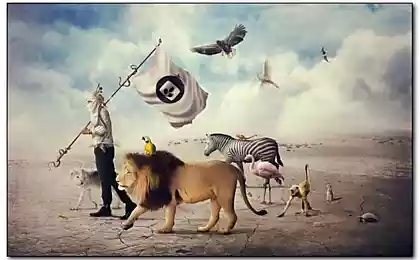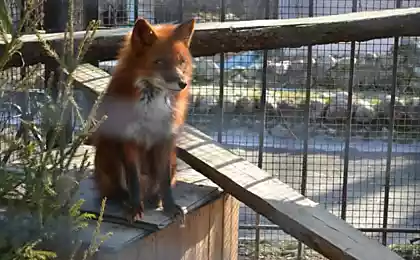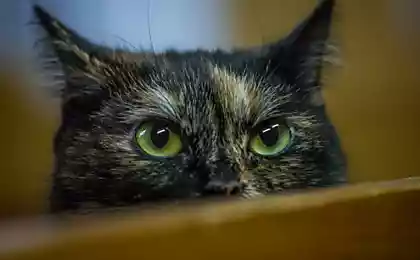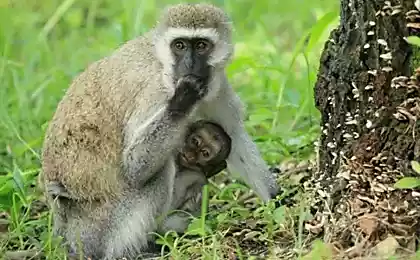966
Ten of the world's deadliest animals
Meeting with animals can often be fatal to humans. What is to be feared the most?
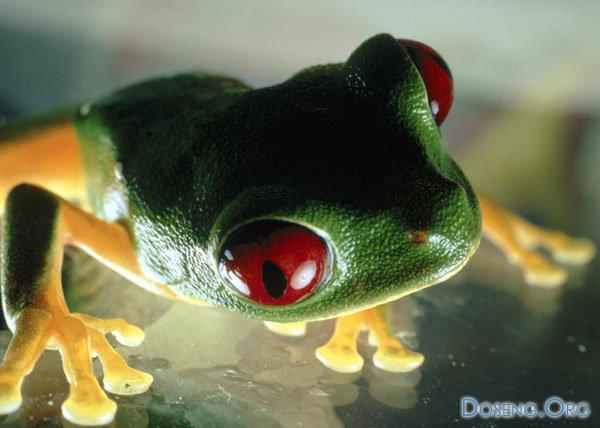
Let's start with the tenth place. He rightfully occupy poisonous frogs that live in Central and South America, Madagascar. On their backs they are arranged glands that produce toxins. The venom of a single golden frogs inhabiting Madagascar, can kill ten people. One consolation - the researchers found that the frog produces toxins gradually and very slowly.
In ninth place is a wild Indian and African buffalo. This is a very dangerous animal, as fears neither man nor other animals. Full-grown male reaches 2 m at the shoulder at a mass of more than 900 kg. Horn is very large, triangular in cross section. They can curl up in a semicircle or widely disperse to the sides of the head, forming a gentle arc.
Record length of horns - 195 cm. Because feelings are particularly well developed sense of smell, although rumor had buffalo is also very sharp. Tourists traveling to Africa, do not have to beware of the lion, and it is this animal. He quickly feels extraneous and can attack first. In preparation for the attack, the male digs land front legs and snorts loudly. Especially dangerous protecting buffalo calves.
The eighth place belongs to the polar bear. In the zoo, they seem to us "white and fluffy", but running a tourist in Svalbard bear catching up instantly, attacking immediately and leaves no chance to survive. Introduced nearly half a century ago, measures to protect the polar bear population within the entire Arctic led to the fact that the number of its fully recovered and even exceeded the permissible limits.
He became the absolute master and an ordinary animal wherever lived in the historical past. But the prohibitions have a disservice to a man almost "bearish." The animal became aggressive, had lost a sense of fear. Often it appears in human settlements. In no case do not approach him and not & quot; lisp & quot; with him. Killing him is not so simple, you can put a dozen bullets, and the beast will transcend all.
In seventh place is located confident elephant. This clever animal, and therefore incomprehensible. Elephants, African and Indian, killing about 500 people a year. A particularly dangerous elephant bum exiled from his herd in the mating season. He throws himself on any moving object.
Sixth place is occupied by a crocodile. In Australia and in many African countries it is considered the most dangerous animals. Do not confuse a crocodile with a log! It may lie still in the water, waiting for a victim. When it appears, in the blink of an eye Hidden predator jumps out of hiding and attack, then it will drag under water to drown and dismember. In the tropics in the north of Australia, there are a hundred thousand reptiles. They are under state protection. At the same time over the past 20 years, we ate crocodiles are believed to more than a dozen people.
Great White Shark confidently holds fifth place. Blood in the water can cause sharks hunger incredible strength. And then, so it will use all 3,000 of their teeth to bite anything that moves. The white shark inhabits the warm waters of all oceans, as well as in the Mediterranean and the Sea of Japan, often reach 7-8 meters in length, and sometimes grow up to 12 meters. The white shark is the most dangerous, fierce and powerful of all the sharks, she was even given the nickname "white killer».
Often it is attacking divers and surfers from the Australian coast and the coast of California. In 2004, a white shark attacked a diver in the South Kuril island of Kunashir. She tore the muscle man left thigh and calf. In addition, due to the sharp rise to the surface in humans evolved syndrome decompression sickness. This type of shark in the waters above the South Kuriles was not observed. Experts believe that the possible cause of the fish there was global warming - the last four years off the coast of Sakhalin Island great white shark caught twice in a network of fishermen.
In fourth place unexpectedly monkey, which in many tropical countries of the forest moved closer to the city dump, finding there own food. Often flocks of monkeys attacking children and even adults, taking food, plunder peasant food stocks and ravaged refrigerators citizens. At the same time they borrow a human tricks and manners, sometimes even adopting the habit of knocking on the door to open it.
Last year, the inhabitants of one of the districts of New Delhi (India) held mass protests, blocking highways and requiring the government to protect people from monkeys.
In third place confidently go poisonous jellyfish. Especially dangerous Australian jellyfish, also known as the sea wasp. This jellyfish the size of a salad bowl can have up to 60 tentacles to 4 meters each. Each tentacle has a 5000 toxic cells and enough toxin to kill 60 people.
Poisonous jellyfish are found in the warm waters of the tropical and subtropical countries. In Italy, even detachments were created, designed to save travelers from the poisonous jellyfish. The reason for the increase in their numbers throughout the scientists believe global warming the world's oceans and the activities of companies that save on sewage treatment plants, dumping into the ocean "food" for the jellyfish.
Second place belongs to poisonous snakes. During the year all over the world is 50000 bites by poisonous snakes fatal to humans. Asian Cobras are responsible for the largest part of them. Typically, snake people are not the first to attack and bite people when disturbed (zadenut, come and so on.). On the territory of our country lives 10 species of poisonous snakes. The most dangerous bites Central Asian cobra, viper and the ephah.
In areas with a hot climate snakes are usually crepuscular lifestyle, and in the afternoon hiding from direct sunlight in the crevices of rocks, rodent holes, abandoned adobe buildings.
In situations where a possible meeting with snakes, you need to take precautions. Therefore, going into the woods, put on rubber boots, pants that do not have close-fitting legs. If your feet shoes, tuck pants into them with an overlap. Take a long stick - staff to push the bushes.
The palm of the deadly animal confidently holds a seemingly harmless animal as the mosquito. Most mosquito bites just makes you just itch. But even the mosquitoes carry malaria, the parasite infects through blood. As a result, these little pests are responsible for the deaths of more than three million people a year.
In sub-Saharan Africa accounts for 85-90% of these cases, the vast majority of infected children under the age of 5 years. The mortality rate is expected to double over the next 20 years.
In Russia, tropical malaria mosquitoes are not transferred, they are immune to it. But if you return from "hot" country feel weak, experienced fainting, unexplained rise in body temperature, not too lazy to do a blood test for the presence of malaria parasites.
© Love Lyul'ko

Let's start with the tenth place. He rightfully occupy poisonous frogs that live in Central and South America, Madagascar. On their backs they are arranged glands that produce toxins. The venom of a single golden frogs inhabiting Madagascar, can kill ten people. One consolation - the researchers found that the frog produces toxins gradually and very slowly.
In ninth place is a wild Indian and African buffalo. This is a very dangerous animal, as fears neither man nor other animals. Full-grown male reaches 2 m at the shoulder at a mass of more than 900 kg. Horn is very large, triangular in cross section. They can curl up in a semicircle or widely disperse to the sides of the head, forming a gentle arc.
Record length of horns - 195 cm. Because feelings are particularly well developed sense of smell, although rumor had buffalo is also very sharp. Tourists traveling to Africa, do not have to beware of the lion, and it is this animal. He quickly feels extraneous and can attack first. In preparation for the attack, the male digs land front legs and snorts loudly. Especially dangerous protecting buffalo calves.
The eighth place belongs to the polar bear. In the zoo, they seem to us "white and fluffy", but running a tourist in Svalbard bear catching up instantly, attacking immediately and leaves no chance to survive. Introduced nearly half a century ago, measures to protect the polar bear population within the entire Arctic led to the fact that the number of its fully recovered and even exceeded the permissible limits.
He became the absolute master and an ordinary animal wherever lived in the historical past. But the prohibitions have a disservice to a man almost "bearish." The animal became aggressive, had lost a sense of fear. Often it appears in human settlements. In no case do not approach him and not & quot; lisp & quot; with him. Killing him is not so simple, you can put a dozen bullets, and the beast will transcend all.
In seventh place is located confident elephant. This clever animal, and therefore incomprehensible. Elephants, African and Indian, killing about 500 people a year. A particularly dangerous elephant bum exiled from his herd in the mating season. He throws himself on any moving object.
Sixth place is occupied by a crocodile. In Australia and in many African countries it is considered the most dangerous animals. Do not confuse a crocodile with a log! It may lie still in the water, waiting for a victim. When it appears, in the blink of an eye Hidden predator jumps out of hiding and attack, then it will drag under water to drown and dismember. In the tropics in the north of Australia, there are a hundred thousand reptiles. They are under state protection. At the same time over the past 20 years, we ate crocodiles are believed to more than a dozen people.
Great White Shark confidently holds fifth place. Blood in the water can cause sharks hunger incredible strength. And then, so it will use all 3,000 of their teeth to bite anything that moves. The white shark inhabits the warm waters of all oceans, as well as in the Mediterranean and the Sea of Japan, often reach 7-8 meters in length, and sometimes grow up to 12 meters. The white shark is the most dangerous, fierce and powerful of all the sharks, she was even given the nickname "white killer».
Often it is attacking divers and surfers from the Australian coast and the coast of California. In 2004, a white shark attacked a diver in the South Kuril island of Kunashir. She tore the muscle man left thigh and calf. In addition, due to the sharp rise to the surface in humans evolved syndrome decompression sickness. This type of shark in the waters above the South Kuriles was not observed. Experts believe that the possible cause of the fish there was global warming - the last four years off the coast of Sakhalin Island great white shark caught twice in a network of fishermen.
In fourth place unexpectedly monkey, which in many tropical countries of the forest moved closer to the city dump, finding there own food. Often flocks of monkeys attacking children and even adults, taking food, plunder peasant food stocks and ravaged refrigerators citizens. At the same time they borrow a human tricks and manners, sometimes even adopting the habit of knocking on the door to open it.
Last year, the inhabitants of one of the districts of New Delhi (India) held mass protests, blocking highways and requiring the government to protect people from monkeys.
In third place confidently go poisonous jellyfish. Especially dangerous Australian jellyfish, also known as the sea wasp. This jellyfish the size of a salad bowl can have up to 60 tentacles to 4 meters each. Each tentacle has a 5000 toxic cells and enough toxin to kill 60 people.
Poisonous jellyfish are found in the warm waters of the tropical and subtropical countries. In Italy, even detachments were created, designed to save travelers from the poisonous jellyfish. The reason for the increase in their numbers throughout the scientists believe global warming the world's oceans and the activities of companies that save on sewage treatment plants, dumping into the ocean "food" for the jellyfish.
Second place belongs to poisonous snakes. During the year all over the world is 50000 bites by poisonous snakes fatal to humans. Asian Cobras are responsible for the largest part of them. Typically, snake people are not the first to attack and bite people when disturbed (zadenut, come and so on.). On the territory of our country lives 10 species of poisonous snakes. The most dangerous bites Central Asian cobra, viper and the ephah.
In areas with a hot climate snakes are usually crepuscular lifestyle, and in the afternoon hiding from direct sunlight in the crevices of rocks, rodent holes, abandoned adobe buildings.
In situations where a possible meeting with snakes, you need to take precautions. Therefore, going into the woods, put on rubber boots, pants that do not have close-fitting legs. If your feet shoes, tuck pants into them with an overlap. Take a long stick - staff to push the bushes.
The palm of the deadly animal confidently holds a seemingly harmless animal as the mosquito. Most mosquito bites just makes you just itch. But even the mosquitoes carry malaria, the parasite infects through blood. As a result, these little pests are responsible for the deaths of more than three million people a year.
In sub-Saharan Africa accounts for 85-90% of these cases, the vast majority of infected children under the age of 5 years. The mortality rate is expected to double over the next 20 years.
In Russia, tropical malaria mosquitoes are not transferred, they are immune to it. But if you return from "hot" country feel weak, experienced fainting, unexplained rise in body temperature, not too lazy to do a blood test for the presence of malaria parasites.
© Love Lyul'ko




